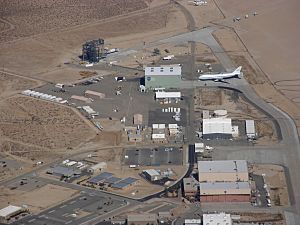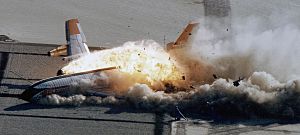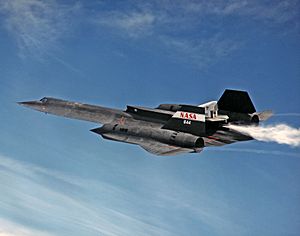Armstrong Flight Research Center facts for kids
 |
|
 Neil A. Armstrong Flight Research Center from the air. |
|
| Agency overview | |
|---|---|
| Preceding agencies |
|
| Jurisdiction | U.S. federal government |
| Headquarters | Edwards Air Force Base, California, United States |
| Agency executive |
|
| Parent agency | NASA |
The NASA Neil A. Armstrong Flight Research Center (AFRC) is a special place where NASA studies and tests airplanes. It's located inside Edwards Air Force Base in California. This center is known as NASA's top spot for testing new ideas in aviation.
AFRC uses some of the most advanced aircraft in the world. It has been part of many aviation "firsts." These include helping the first crewed airplane fly faster than the speed of sound (the Bell X-1). It also supported the fastest speed ever reached by a crewed, powered aircraft (the North American X-15). AFRC also worked on the first pure digital fly-by-wire aircraft (F-8 DFBW).
The center used to have another location called Building 703 in Palmdale, California. This building was once a factory for making airplanes. At Building 703, AFRC kept and flew several NASA science planes. These included SOFIA, a DC-8 Flying Laboratory, and an ER-2 High Altitude Platform. In 2024, NASA moved out of Building 703. This happened after SOFIA and the DC-8 planes were retired. It was no longer needed to lease such a big hangar. As of 2023, Bradley Flick is the director of the center.
The center started in 1946 as the Muroc Flight Test Unit. It changed names several times over the years. In 1976, it became the NASA Ames-Dryden Flight Research Center (DFRC). This name honored Hugh L. Dryden, a famous aeronautical engineer. He was NASA's deputy administrator. The center got its current name, Neil A. Armstrong Flight Research Center, in 2014. This was to honor Neil Armstrong, who was a test pilot there. He was also the first human to walk on the Moon.
AFRC was also home to the Shuttle Carrier Aircraft (SCA). This was a special Boeing 747 plane. It was designed to carry a Space Shuttle orbiter back to Kennedy Space Center. This would happen if a Shuttle landed at Edwards Air Force Base.
The center also used the oldest B-52 Stratofortress bomber for a long time. This B-52B was called Balls 8. It was changed to be a drop test aircraft. Balls 8 dropped many supersonic test vehicles. These ranged from the X-15 to its last research program, the hypersonic X-43A. The X-43A was powered by a Pegasus rocket. Balls 8 was retired in 2004. You can now see it on display near Edwards' North Gate.
Contents
Location and Environment
The Armstrong Flight Research Center has always been on the shore of Rogers Dry Lake. Its exact spot has moved a bit over the years. Today, it's on the northwest side of the lake bed. It's just south of the North Gate. Visitors need special permission to enter both Edwards AFB and NASA AFRC.
The Rogers Dry Lake bed is a unique place for flight research. It's very dry and doesn't get much rain. It also has huge, flat, open spaces. This makes it perfect for emergency landings. Sometimes, the lake bed can have a runway over 40,000 feet long. It also has a giant compass rose, which is 5,200 feet across. Planes can land there facing any direction, depending on the wind.
Current Research Projects
NASA Armstrong Flight Research Center is always working on exciting new projects. Here are some of them:
- X-59 QueSST
- X-66 Sustainable Flight Demonstrator
- UAS in the NAS (Unmanned Aircraft Systems in the National Airspace System)
- TGALS (Tactical Global Air-Land System)
Historic Flight Projects
AFRC has been involved in many important flight tests and research projects throughout history.
Douglas Skyrocket

NASA's earlier version, the NACA, flew the Douglas Skyrocket. This plane was a follow-up to the Air Force's Bell X-1. The D-558-II could fly using either rocket or jet power. It did many tests to understand how planes fly at high speeds. This included studying stability in the transsonic range (near the speed of sound). It also looked at the best wing shapes for supersonic flight.
On November 20, 1953, the Douglas Skyrocket became the first plane to fly at more than twice the speed of sound. It reached Mach 2.005. Like the X-1, the D-558-II could be launched from a B-29 Superfortress plane high in the air. But unlike the X-1, the Skyrocket could also takeoff from a runway. It used special JATO (Jet-Assisted Take-Off) units for this.
Controlled Impact Demonstration

The Controlled Impact Demonstration was a project with the Federal Aviation Administration. They wanted to test a new jet fuel. This fuel was supposed to reduce fire damage if a large airliner crashed. On December 1, 1984, a Boeing 720 plane was flown by remote control. It crashed into special "wing openers" that tore its wings open. Fuel sprayed everywhere.
Even with the new fuel additive, the resulting fireball was huge. It took an hour to put out the fire completely. The fuel additive didn't stop a fire, but the research was still helpful. The additive did prevent some fuel from burning. This unburnt fuel flowed over the plane's body and helped cool it down. Also, crash test dummies were inside the plane during the crash. They gave important information about how people could survive plane crashes.
Linear Aerospike SR-71 Experiment
LASRE was a NASA experiment with Lockheed Martin. It studied a design for a reusable launch vehicle. This vehicle would use a linear aerospike rocket engine. The goal was to get real flight data. This data would help Lockheed Martin check their computer tools used to design the craft.
LASRE was a small model of a lifting body. It had eight small engines like an aerospike engine. This experiment was placed on the back of an SR-71 Blackbird aircraft. It worked like a "flying wind tunnel." The experiment looked at how the engine's exhaust plume would affect the plane's shape. This was tested at certain heights and speeds, up to about 340 miles per hour. The way the air flow and engine plume interact can create drag. The goal was to design the vehicle to have as little drag as possible.
Lunar Landing Research Vehicle
The Lunar Landing Research Vehicle, or LLRV, was part of the Apollo Project. It was built to help astronauts practice landing on the Moon. These LLRVs were sometimes called "Flying Bedsteads" because of their shape. They were used at the Flight Research Center (now Armstrong Flight Research Center) at Edwards Air Force Base. Astronauts used them to learn how to fly and land the Apollo Lunar Module. This was important because the Moon has no air.
Aircraft on Display
You can see several historic aircraft on display at the Armstrong Flight Research Center:
- NB-52B Balls 8 NASA 008
- Bell X-1E AF Ser. No. 46-063
- F-104N - NASA 826
- F-8 Supercritical wing - NASA 810
- F-8 Digital Fly-by-wire - NASA 802
- F-15B ACTIVE - NASA 837
- Grumman X-29 - NASA 849
- Lockheed SR-71 Blackbird LASRE - NASA 844
- Northrop HL-10 Lifting Body - NASA 804
- Rockwell HiMAT
Gallery
-
The satellite image of Armstrong Flight Research Center and the Edwards compass rose
-
F-16-based VISTA multifunctional testbed aircraft (former NF-16D and now X-62A) in 2019 under a new paint scheme
Center Directors
Here is a list of the people who have led the Armstrong Flight Research Center over the years:
| No. | Image | Director | Start | End | Notes |
|---|---|---|---|---|---|
| 1 |  |
Walter C. Williams | September 30, 1946 | Fall 1949 | Supervisor, NACA Muroc Flight Test Unit |
| Fall 1949 | July 1, 1954 | Supervisor, NACA High Speed Flight Research Station | |||
| July 1, 1954 | September 15, 1959 | Director, NACA High Speed Flight Station | |||
| 2 |  |
Paul F. Bikle | September 15, 1959 | May 31, 1971 | |
| Acting |  |
De E. Beeler | June 1, 1971 | October 11, 1971 | |
| 3 |  |
Lee R. Scherer | October 11, 1971 | January 19, 1975 | |
| 4 |  |
David R. Scott | April 18, 1975 | October 30, 1977 | |
| Acting | Isaac T. Gillam | October 30, 1977 | June 18, 1978 | ||
| 5 | June 18, 1978 | October 1, 1981 | |||
| 6 |  |
John A. Manke | October 1, 1981 | April 27, 1984 | Director of Flight Operations |
| 7 |  |
Martin Knutson | May 1984 | December 2, 1990 | Director of Flight Operations and Site Director |
| 8 |  |
Kenneth J. Szalai | December 3, 1990 | March 1, 1994 | Facility Director |
| March 1, 1994 | July 31, 1998 | ||||
| Acting |  |
Kevin L. Petersen | August 1, 1998 | February 7, 1999 | |
| 9 | February 8, 1999 | April 3, 2009 | |||
| Acting |  |
David D. McBride | April 4, 2009 | January 3, 2010 | |
| 10 | January 4, 2010 | December 4, 2022 | |||
| 11 |  |
Bradley Flick | December 5, 2022 | present |
Famous People Who Worked Here
Many notable people have worked at the Armstrong Flight Research Center, including:
- Neil Armstrong
- Marta Bohn-Meyer
- Bill Dana
- C. Gordon Fullerton
- David Hedgley
- Bruce Peterson
- R. Dale Reed
- David Scott
- Milt Thompson
- J. Scott Howell
- Kenneth W. Iliff
See also
 In Spanish: Centro de Investigaciones de Vuelo Armstrong para niños
In Spanish: Centro de Investigaciones de Vuelo Armstrong para niños
- Gromov Flight Research Institute - Russia's similar flight research center
- List of aerospace flight test centres







